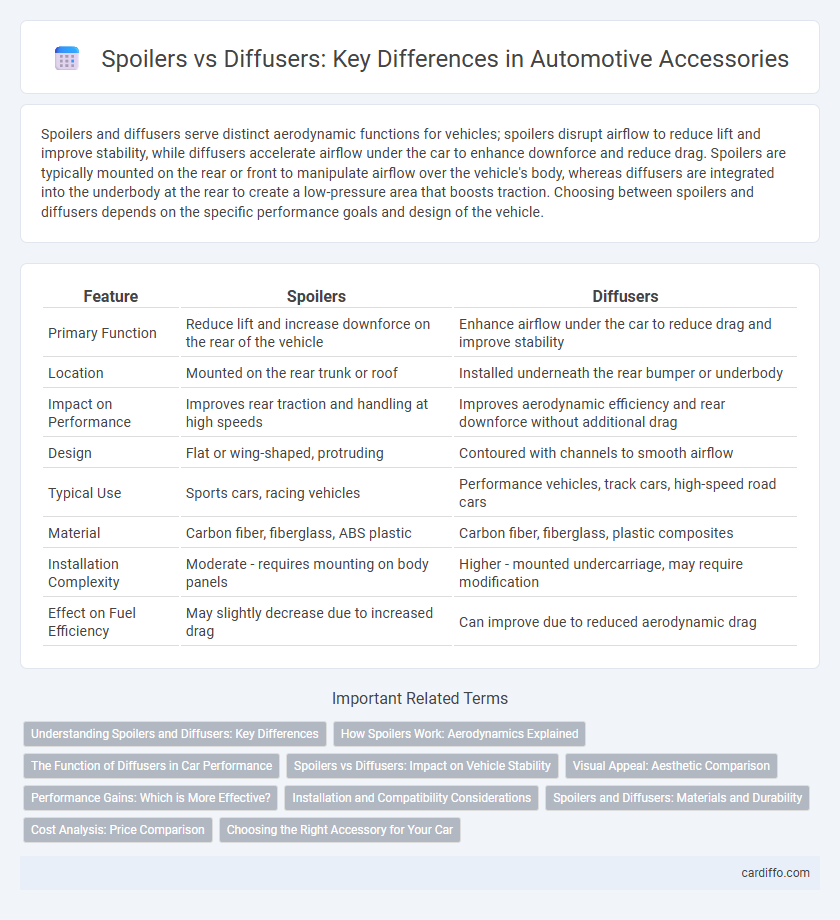Spoilers and diffusers serve distinct aerodynamic functions for vehicles; spoilers disrupt airflow to reduce lift and improve stability, while diffusers accelerate airflow under the car to enhance downforce and reduce drag. Spoilers are typically mounted on the rear or front to manipulate airflow over the vehicle's body, whereas diffusers are integrated into the underbody at the rear to create a low-pressure area that boosts traction. Choosing between spoilers and diffusers depends on the specific performance goals and design of the vehicle.
Table of Comparison
| Feature | Spoilers | Diffusers |
|---|---|---|
| Primary Function | Reduce lift and increase downforce on the rear of the vehicle | Enhance airflow under the car to reduce drag and improve stability |
| Location | Mounted on the rear trunk or roof | Installed underneath the rear bumper or underbody |
| Impact on Performance | Improves rear traction and handling at high speeds | Improves aerodynamic efficiency and rear downforce without additional drag |
| Design | Flat or wing-shaped, protruding | Contoured with channels to smooth airflow |
| Typical Use | Sports cars, racing vehicles | Performance vehicles, track cars, high-speed road cars |
| Material | Carbon fiber, fiberglass, ABS plastic | Carbon fiber, fiberglass, plastic composites |
| Installation Complexity | Moderate - requires mounting on body panels | Higher - mounted undercarriage, may require modification |
| Effect on Fuel Efficiency | May slightly decrease due to increased drag | Can improve due to reduced aerodynamic drag |
Understanding Spoilers and Diffusers: Key Differences
Spoilers and diffusers serve distinct aerodynamic functions on vehicles, with spoilers primarily designed to disrupt airflow and reduce lift, enhancing stability at high speeds, while diffusers manage airflow under the car by accelerating it to reduce pressure and increase downforce. Spoilers are commonly mounted on the rear to improve traction and control, whereas diffusers are integrated into the vehicle's underbody to optimize aerodynamic efficiency and reduce drag. Understanding these differences is crucial for selecting the right accessory tailored to performance or aesthetics in automotive design.
How Spoilers Work: Aerodynamics Explained
Spoilers improve vehicle stability by disrupting airflow to reduce lift and increase downforce, enhancing traction at higher speeds. They manipulate aerodynamic pressure, preventing air from creating lift under the car, which can cause instability. By redirecting airflow, spoilers optimize handling and cornering performance, especially in sports and performance vehicles.
The Function of Diffusers in Car Performance
Diffusers enhance car performance by managing airflow under the vehicle to reduce drag and increase downforce, improving stability at high speeds. By accelerating air exit from beneath the car, diffusers create a low-pressure zone that helps to suck the car closer to the road, optimizing grip and cornering ability. This aerodynamic component works in synergy with spoilers but primarily focuses on underbody airflow control for superior handling efficiency.
Spoilers vs Diffusers: Impact on Vehicle Stability
Spoilers enhance vehicle stability by disrupting airflow and reducing lift, increasing traction at high speeds for better control. Diffusers improve stability by accelerating airflow underneath the car, creating downforce that presses the vehicle closer to the road surface. Both accessories optimize aerodynamic performance but function differently to maintain balance and handling.
Visual Appeal: Aesthetic Comparison
Spoilers and diffusers both enhance a car's visual appeal but in distinct ways; spoilers typically add a sporty, aggressive look by altering the vehicle's rear profile, while diffusers emphasize a sleek, aerodynamic underbody design that suggests performance. Spoilers are often more prominent and eye-catching, creating a bold statement, whereas diffusers provide a subtle, refined aesthetic that complements the car's overall styling. Choosing between them depends on whether a driver prefers a dramatic or understated enhancement to their vehicle's exterior.
Performance Gains: Which is More Effective?
Spoilers primarily enhance high-speed stability by disrupting airflow and reducing lift, improving traction during cornering and braking. Diffusers optimize underbody airflow, increasing downforce without significantly adding drag, which enhances overall vehicle grip and efficiency. For raw performance gains, diffusers generally offer more effective aerodynamic benefits by improving both stability and acceleration.
Installation and Compatibility Considerations
Spoilers generally require precise mounting points on the vehicle's trunk or rear hatch, often involving drilling or adhesive application, which can affect installation complexity and vehicle compatibility. Diffusers install on the underside of the rear bumper and demand careful fitment to ensure proper airflow management, often designed to fit specific models for optimal performance. Both accessories must be chosen with vehicle make, model, and year in mind to guarantee proper installation and aerodynamic effectiveness.
Spoilers and Diffusers: Materials and Durability
Spoilers are typically made from lightweight materials such as fiberglass, ABS plastic, or carbon fiber, offering a balance between durability and weight reduction. Diffusers often utilize reinforced plastics or carbon fiber composites to withstand aerodynamic forces and heat exposure while maintaining structural integrity. Both accessories require coatings or treatments to resist environmental damage, but carbon fiber variants boast superior strength-to-weight ratios and long-term durability in automotive applications.
Cost Analysis: Price Comparison
Spoilers generally cost between $150 and $500 depending on material and brand, while diffusers range from $100 to $400, offering a more budget-friendly option for aerodynamic enhancement. Installation costs for spoilers can add an extra $100 to $300, whereas diffusers are typically simpler to install, costing around $50 to $150. Overall, diffusers present a more cost-effective solution for improving vehicle stability without compromising budget constraints.
Choosing the Right Accessory for Your Car
Choosing the right car accessory requires understanding the distinct benefits of spoilers and diffusers, which both enhance aerodynamics but serve different purposes. Spoilers reduce lift and increase stability at high speeds by disrupting airflow over the vehicle's rear, while diffusers improve underbody airflow, reducing drag and increasing downforce for better traction. Prioritize your driving style and performance goals to select an accessory that effectively balances aesthetics with functional improvements in handling and efficiency.
Spoilers vs diffusers Infographic

 cardiffo.com
cardiffo.com